1. Introduction to The Decimals
- Books Name
- CBSE Class 6 Mathematics Book
- Publication
- Param Publication
- Course
- CBSE Class 6
- Subject
- Mathmatics
Decimals
Decimals are an extension of our number system For an example 5.75. Here the dot represents a decimal point. Decimals are fractions whose denominators are 10, 100, 1000 etc. A decimal has two parts, namely, the whole number part and decimal part.
Decimal Places : The number of digits contained in the decimal part of a decimal number is known as the number of decimal places.
For example :
3.75 has two decimal places and 85.325 has three decimal places.
Division of a unit in ten equal parts
If an object is divided into 10 equal parts then its each part is one tenth of the whole. It is written as ![]()
![]() is also written as 0.1 and is read as 'one tenth' or point one'.ss
is also written as 0.1 and is read as 'one tenth' or point one'.ss
Ex. 0.5 is read as 5 tenth. or point five.
It can be written as 2.3 and read as two point three.
Let us take an example, there is two tower each consist two blocks and each block is equal to one unit than tower represents 10 units. So, the number shown here is :
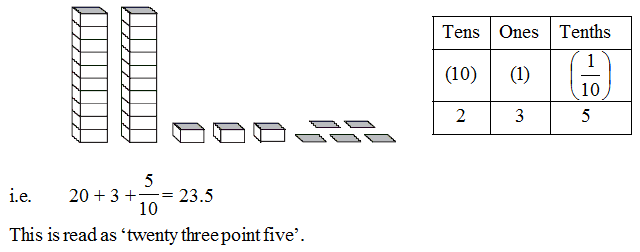
Representing Decimals on number line
We represented fractions on a number line. Let us now represent decimals too on a number line. Let us represent 0.6 on a number line. We know that 0.6 is more than zero but less than one. There are 6 tenths in it. Divide the unit length between 0 and 1 into 10 equal parts and take 6 parts as shown below :

Ex.1 Write the following numbers in the place value table : (a) 20.5 (b) 4.2
Sol.: Let us make a common place value table, assigning appropriate place value to the digits in the given numbers. We have,
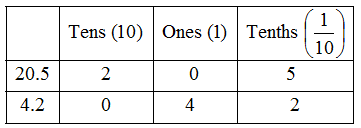
Ex.2 Write each of the following as decimals : (a) Two ones and five-tenths (b) Thirty and one-tenth
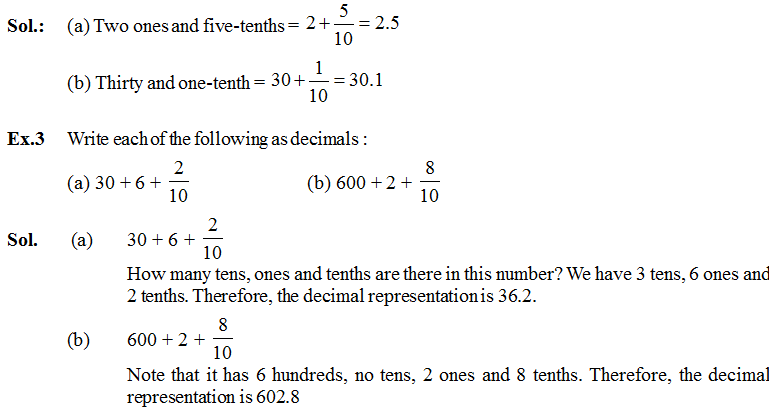
1. Introduction to The Decimals
- Books Name
- Class 6 Mathematics Book
- Publication
- ReginaTagebücher
- Course
- CBSE Class 6
- Subject
- Mathmatics
Introduction to The Decimals
What is decimal?
The Numbers used to represent Numbers lower than unit 1 are called decimal numbers. The decimal point or the period plays a significant part in a Decimal Number. This period separates the fractional part and whole number part in a decimal number. Place value of a number can be defined as the value of a number as per the place of that number in a number. Decimals Exemplifications Let us consider a decimal number0.5694 to see the different place values of each number.
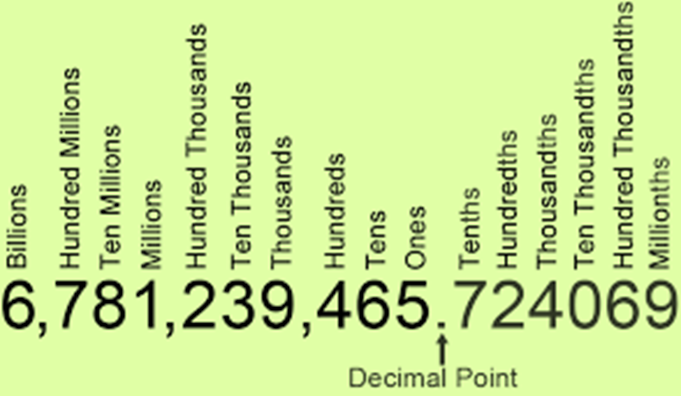
The value of the number at the first place after the decimal point is tenths place value. Tenths can be calculated as 1 unit divided in 10 equal corridor i.e. 0.1. Thus, considering this there are 5 tenths in the number0.5694.
The value of the number at the alternate place after the decimal point is hundredths place value. The number in that place tells you how numerous hundredths are there. Hundredths can be calculated as 1 unit divided in100 equal parts.i.e0.01. thus, considering this there are 6 hundredths in the number0.5694
The value of the number at the third place after the decimal point is thousandths place value. The number in that place tells you how numerous thousandths are present. Thousandths can be calculated as 1 unit divided in1000 equal corridor i.e. 0.001. Thus, considering this there are 9 thousandths in the number0.5694
Ten- thousandths
The value of the number at the fourth place after the decimal point is ten- thousandths place value. The number in that place tells you how numerous ten- thousandths are present. Ten- thousandths can be calculated as 1 unit divided into 10000 equal corridori.e0.0001. Thus, Considering this there are 4 thousandths in the number0.5694
For Example:
23/10 can be written in decimal as 2.3
23/100 can be written in decimal as 0.23
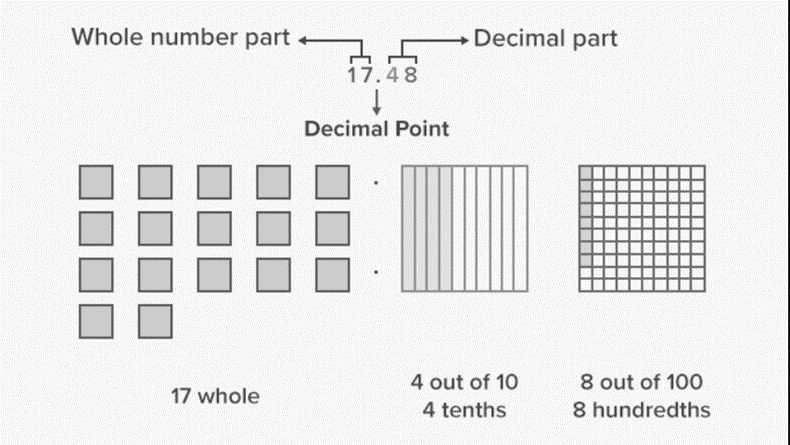
Knowing about Tenths
As we know that 1 cm = 10 mm, so if we have to find the contrary also
1 mm = 1/10 cm or one-tenth cm or0.1 cm.
Hence, the first number after the numeric represents the tenth part of the whole.
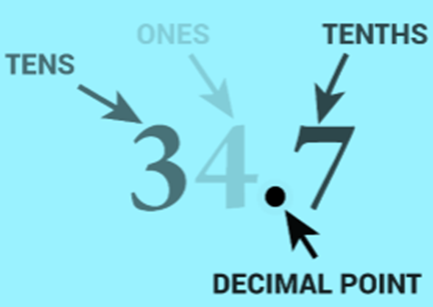
Tenths
This reads as “thirty-four point seven ”.
Representation of decimals on the number line,
Let us suppose we have to represent0.5 on the number line.
is lesser than 0 and lower than 1 also it can be represented on number line by dividing unit length between 0 and 1 into ten equal corridor and the fifth part will represent 0.5

Knowing about Hundredths,
In Hundredth, one block is divided into 100 equal regions and each part comprises1/100 of the entire block.
If a square is divided into 100 small squares the area of each small square will be1/100 or one hundredth of the entire square.
The area of the lower square shaded red is one hundredth of the entire square.
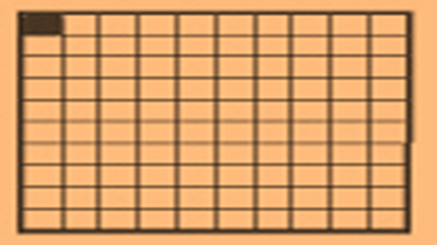
The decimal note is1/100 = 0.01.
Comparing decimals
While comparing two decimal numbers, we consider the following rules
We compare the place values of integers from left to the right.
Extra zeroes to the right of the last number of a decimal value do not change the value of the number.
Redundant depths between decimal point and a decimal number do not change its value.
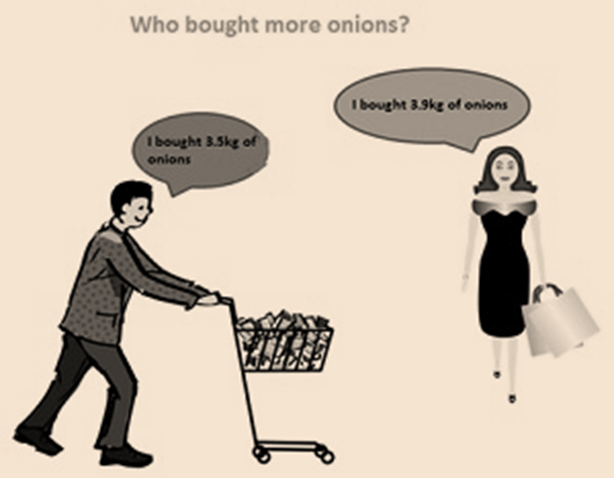
Relationship between fractions and decimals
Numbers are values of fragments. Therefore, fragments can be converted into numbers and numbers can be converted into fragments.
Numbers as fragments
Conversion is done by seeing the place value of numbers.
In conversion to bit, the numeric can be written simply as a number with denominator having as numerous depths as the number of integers after the decimal point.
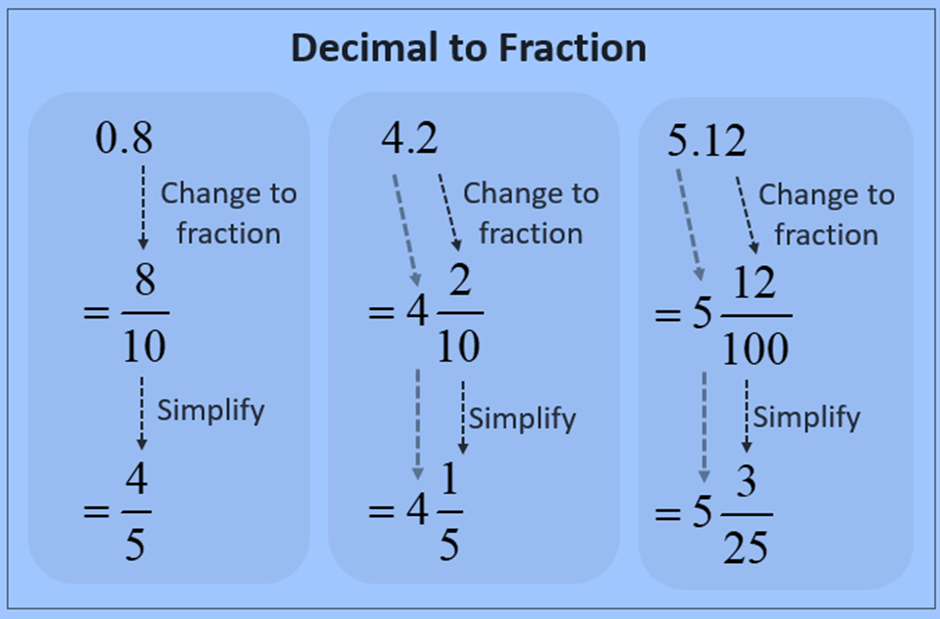
Problem Write the following as fragments in smallest forms.0.05
Result
Then 0 is at Ones place, 0 is at tenths place and 5 is at hundredths place.
= 0 * 1 0 *1/10 5 *1/100
= 0 05/100
= 5/100
= 1/20
There are two integers after the decimal point.
= 1/20
2. Decimals in Measurement
- Books Name
- CBSE Class 6 Mathematics Book
- Publication
- Param Publication
- Course
- CBSE Class 6
- Subject
- Mathmatics
Division of a unit in hundred equal parts
If an object is divided into 100 equal parts then its each part is one hundredth of the whole. It is written 
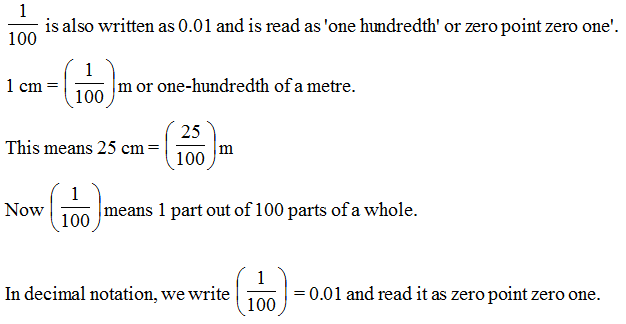
Let us look at some more place value tables.

Ex.1 Given the place value table, write the number in decimal form.
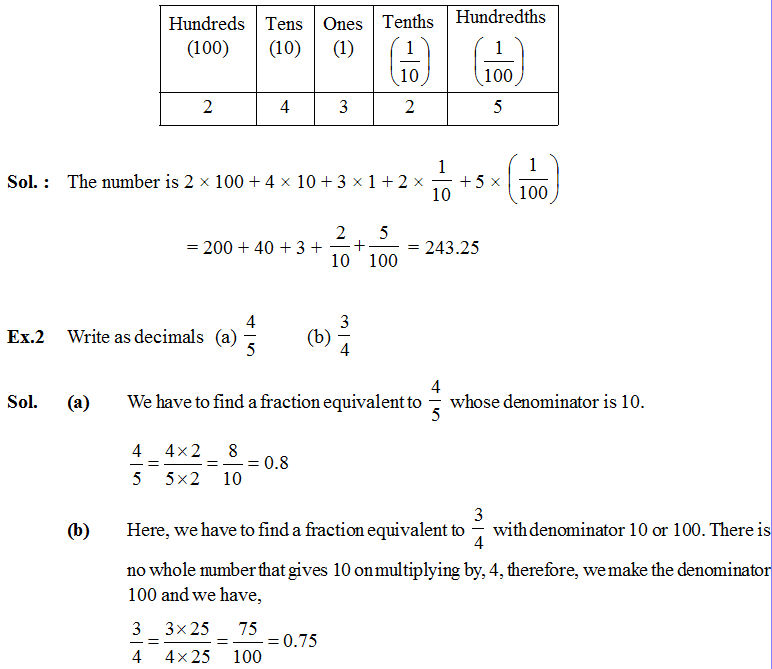
Ex.3 Write as fractions in lowest terms (a) 2.34 (b) 0.342

2. Decimals in Measurement
- Books Name
- Class 6 Mathematics Book
- Publication
- ReginaTagebücher
- Course
- CBSE Class 6
- Subject
- Mathmatics
Decimals in Measurement
Usage of decimals in money
Dealing with decimal numbers is certain, when dealing with money. In numerous situations, similar as when we have to convert paisa into rupee. Suppose we go to an original shop to buy 500 gm of turmeric, where, one kg of turmeric costs Rs. 51. So, how important Money should we hand over to the shopkeeper? We divide Rs. 51 by 2, which is equal to25.5. In order to hand over the exact quantum, we must understand what25.5 means in terms of rupees. Let us learn this with the help of a simple illustration.
1 Rs. = 100 paise
1 paise = 1/100 paise
1 paise = Rs. 0.01
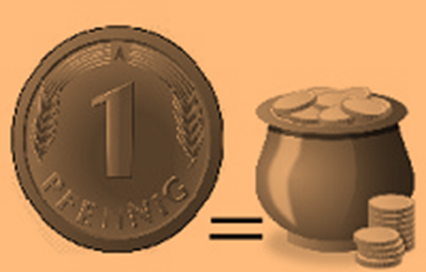
Usage of decimals in length
While measuring the length of an item, it is not necessary that the length of an object is a multiple of the given scale. For illustration, while measuring the length of a table with a metre scale, the length may not be a whole number; it may lie between two ladders on the metre scale. In similar situations, the decimal numbers are used.
1metre = 100 cms
1 cm = 1/100 m
1cm = 0.01 m
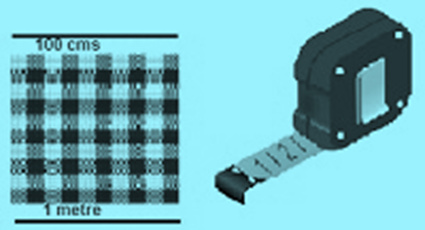
Usage of decimals in weight
We use decimal numbers while dealing with weight. For illustration, when we are buying a watermelon, it can not always weigh in whole numbers; it can be lower than 2 kg but further than 1 kg. In similar situations, the shopkeeper has to calculate how important to charge for a watermelon, grounded on its weight
1kg = 1000 grams
gram = 1/1000 kgs
1 gram = 0.001 kgs
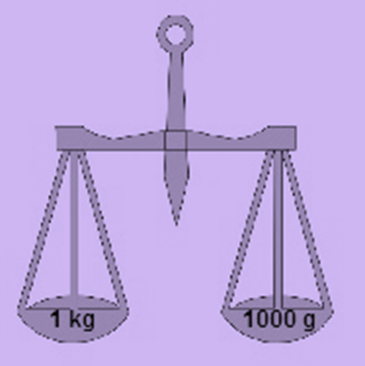
3. Addition and Subtraction of Decimals
- Books Name
- CBSE Class 6 Mathematics Book
- Publication
- Param Publication
- Course
- CBSE Class 6
- Subject
- Mathmatics
Comparing decimals
Decimal numbers may be compared by using the following steps :
Step I Obtain the decimal numbers.
Step II Compare the whole number parts of the numbers. The number with greater whole number part will be greater. If the whole number parts are equal, go to next step.
Step III Compare the extreme left digits of the decimal parts of two numbers. The number with greater extreme left digit will be greater. If the extreme left digits of decimal parts are equal, then compare the next digits and so on.
Ex.1 Which is greater of 48.23 and 39.35 ?
Sol. The given decimals have distinct whole number parts, so we compare whole number parts only.
In 48.23, the whole number part is 48.
In 39.35, the whole number part is 39.
∵48 > 39
∴ 48.23 > 39.35
Ex.2 Write the following decimals in ascending order :
5.64, 2.54, 3.05, 0.259 and 8.32
Sol Converting the given decimals into like decimals, we get :
5.640, 2.540, 3.050, 0.259 and 8.320
Clearly, 0.259 < 2.540 < 3.050 < 5.640 < 8.320
Hence, the given decimals in the ascending order are
0.259, 2.54, 3.05, 5.64 and 8.32
Using Decimals
Decimal properties can be used in variuos day to day examples
(1) Money
We know that 100 paise = M1
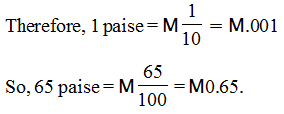
(2) Length : If we want to measure the length of the table in metres. We had a 50 cm scale.
We found that the length of the table top was 156 cm.

(3) Weight : We bought 500g potatoes, 250g capsicum, 700g onions, 500g tomatoes, 100g ginger and 300g radish. Then the total weight of the vegetables in the bag is given by
= 500 g + 250 g + 700 g + 500 g + 100 g + 300 g = 2350 g
3. Addition and Subtraction of Decimals
- Books Name
- Class 6 Mathematics Book
- Publication
- ReginaTagebücher
- Course
- CBSE Class 6
- Subject
- Mathmatics
Addition and Subtraction of Decimals
Addition of decimals,
Addition of numbers numbers is same as addition of whole numbers. The only difference is that we insure that all decimal points will be in same column before addition. We use the following way to add the numbers.
Write the integers of the given decimal numbers one below the other similar that all the decimal points are in the same perpendicular Line.
Add as you add whole numbers.
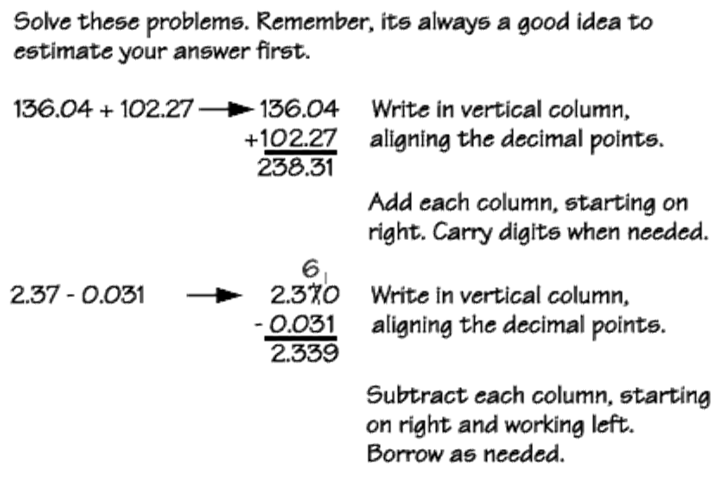
Subtraction of decimals
Deduction of numbers numbers is same as deduction of whole numbers. The only difference is to insure that all decimal points will be in same column before deduction.
We use the following way for deduction of numbers.
Write the two numbers numbers, writing the bigger number first in columns similar that the decimal points are in the same column and the integers having the same place values are in the same column.
Decrease the numbers (ignoring the decimal points) as in the case of whole numbers.
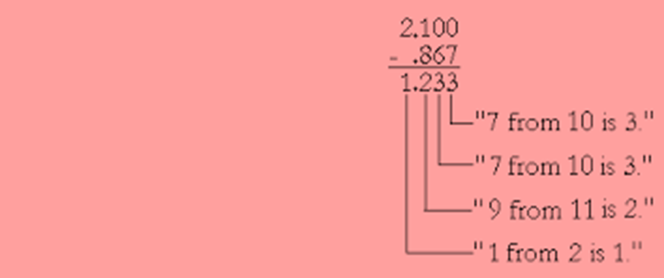
Put the decimal point in the result directly under the decimal points of the two given numbers.
Subtracting of Decimals
- Books Name
- CBSE Class 6 Mathematics Book
- Publication
- Param Publication
- Course
- CBSE Class 6
- Subject
- Mathmatics
Subtraction of Decimals
Addition and Subtraction of Decimals : Decimals can be added or subtracted by using the following steps:
Step I Convert the given decimals to like decimals (same decimal places).
Step II Write the decimals in columns with their decimal points directly below each other so that tenths come under tenths, hundredths come under hundredths and so on.
Step III Add or subtract as we add or subtract whole numbers.
Step IV Place the decimal point, in the answer, directly below the other decimal points.
Ex.1 Lata spent M9.50 for buying a pen and M2.50 for one pencil. How much money did she spend?
Sol.: Money spent for pen = M9.50
Money spent for pencil = M 2.50
Total money spent = M9.50 + M2.50
Total money spent = M12.00
Ex.2 Rahul bought 4 kg 90 g of apples, 2 kg 60 g of grapes and 5 kg 300 g of mangoes. Find the total weight of all the fruits he bought.
Sol.: Weight of apples = 4 kg 90 g = 4.090 kg
Weight of grapes = 2 kg 60 g = 2.060 kg
Weight of mangoes = 5 kg 300 g = 5.300 kg
Therefore, the total weight of the fruits bought is
4.090 kg
2.060 kg
+ 5.300 kg
11.450 kg
Total weight of the fruits bought = 11.450 kg.
Ex.3 Amit bought a Maths book for Rs. 45.60 and a geometry box for Rs. 62.55. What is the total amount spent by Amit ?
Sol. Money spent on Maths book = Rs. 45.60
Money spent on Geometry box = Rs. 62.55
∴ Total amount spent = Rs. 45.60 + Rs. 62.55 = Rs. 108.15
Ex.4 An empty box weighs 1 kg 240 g. When filled with oranges it weighs 19 kg 70 g. What is the weight of the oranges ?
Sol. Weight of empty box = 1 kg 240 g = 1.240 kg
Weight of box with oranges = 19 kg 70 g = 19.070 kg
∴ Weight of oranges = 19.070 kg – 1.240 kg = 17.830 kg.
Ex.5 A can can hold 12.5 litres of mixed fruit juice. 4.035 litres of apple juice and 6 litres 15 ml of orange juice have been poured in the can. What would be the amount of grape juice that can still be added in the can?
Sol. Amount of apple juice = 4.035 L
Amount of orange juice = 6 litres 15 mL = 6.015 L
Capacity of can = 12.5 L
∴ Reqd. amount of grape juice = 12.5 L – (4.035 + 6.015) L = 12.5 L – 10.050 L = 2.45 L
Multiplication & Dividing a decimal by a whole number
- Books Name
- CBSE Class 6 Mathematics Book
- Publication
- Param Publication
- Course
- CBSE Class 6
- Subject
- Mathmatics
Multiplication of a decimal by another decimal:
To multiply a decimal by another decimal, we follow following steps :
Step I Multiply the two decimals without decimal point just like whole numbers.
Step II Insert the decimal point in the product by counting as many places from the right to left as the sum of the number of decimal places of the given decimals.
Ex.1 Find the product of 9.2 and 6.07.
Sol. We have,

∴ 92 × 607 = 55844
Since the sum of the decimal places in the given decimals is 1 + 2 = 3.
So, the product must contain 3 places of decimals. Hence 9.2 × 6.07 = 55.844
Ex.2 Multiply 0.0345 by 0.0237
Sol. We have,
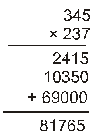
∴ 345 × 237 = 81765
We observe that the sum of the decimals in the given decimals is 4 + 4 = 8
So, the product must contain 8 places of decimals.
Hence, 0.0345 × 0.0237 = 0.00081765
Dividing a decimal by a whole number
A decimal can be divided by a whole number by using the following steps :
Step I Check the whole number part of the dividend.
Step II If the whole number part of the dividend is less than the divisor, then place a ‘0’ in the ones place in the quotient, other wise, go to step iii.
Step III Divide the whole number part of the dividend.
Step IV Place the decimal point to the right of ones place in the quotient obtained in step I.
Step V Divide the decimal part of the dividend by the divisor. If the digits of the dividend are exhausted, then place zeros to the right of dividend and remainder each time and continue the process.
Ex.1 Divide 93.45 by 15.
Sol. We have,
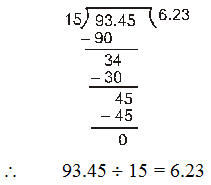
Ex.2 Divide 42.8 by 0.02
Sol. We have,

Ex.3 Divide 0.0024 by 0.04
Sol. We have,
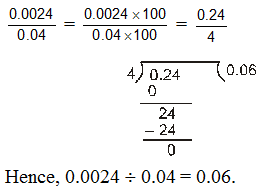
Ex4 The product of two decimals is 1.5008 . If one of them is 0.56, find the other.
Sol. Product of given decimals = 1.5008.
One decimal = 0.56.


 Param Publication
Param Publication
 ReginaTagebücher
ReginaTagebücher
